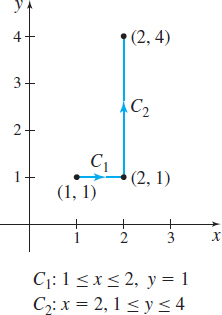EXAMPLE 2Using the Fundamental Theorem of Line Integrals
F=F(x,y)=(2xy+24x)i+(x2+16)j is a conservative vector field, since F is the gradient of f(x,y)=x2y+12x2+16y. Use this fact to find ∫C[(2xy+24x)dx+(x2+16)dy]
where C is any piecewise-smooth curve joining the points (1,1) and (2,4).
Solution We use two methods to find ∫C[(2xy+24x)dx+(x2+16)dy].
Method I uses the potential function f(x,y)=x2y+12x2+16y whose gradient is ∇ f=(2xy+24x)i+(x2+16)j=F(x,y)
and the Fundamental Theorem of Line Integrals. ∫C[(2xy+24x)dx+(x2+16)dy]=[f(x,y)](2,4)(1,1)=f(2,4)−f(1,1)=[(22)(4)+12(22)+16(4)]−[(12)(1)+12(12)+16(1)]=99
Method II uses the fact that the given line integral is independent of the path, so it can be integrated along any piecewise-smooth curve joining (1,1) and (2,4). We choose the path shown in Figure 23 since it makes the integration easy. So, along C1, dy=0,
and along C2, dx=0. Then ∫C[(2xy+24x)dx+(x2+16)dy]=∫C1[(2xy+24x)dx+(x2+16)dy]+∫C2[(2xy+24x)dx+(x2+16)dy]=∫21(2x+24x)dx+∫41(4+16)dy=39+60=99
